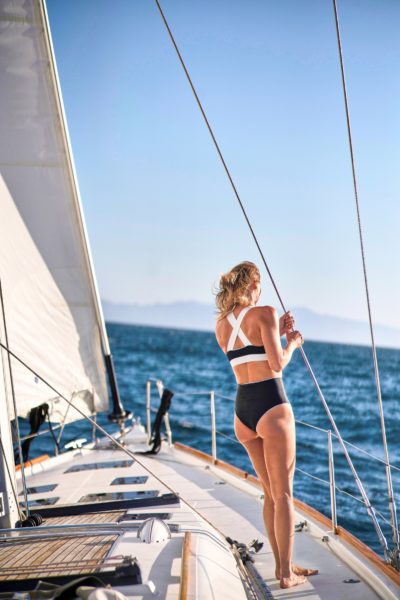For those of us who spent the early 2000s in high school or college, the name Abigail Lorick might sound curiously familiar. To refresh memories, Lorick was the “ghost designer” of Eleanor Waldorf’s fashion line in the TV series Gossip Girl, and her dresses quickly became an obsession for girls who loved Blair Waldorf and Serena van der Woodsen’s style. (Lorick’s candy-colored “braless” dresses with low backs have been especially popular in Instagram #TBTs of late.)
In the decade since, Lorick has designed for & Other Stories and Cynthia Rowley, and most recently led the design team at Stance in southern California. Her Stance experience plunged her back into the world of “action sports,” one she knew well from her days of competitive surfing in high school; SoCal is home to Quiksilver, Hurley, and nearly every other surf brand. Even after nearly two decades away from the sport, Lorick was surprised to find that the “junior” aesthetic of women’s surfing had hardly changed; it was still about bohemian prints and barely-there bikinis, which appealed to her not at all as a working woman and new mother.
The current state of affairs might have had something to do with the fact that all surf brands—including women-oriented ones—are run by men. “When that’s the case, you can easily miss the mark on what women really want,” Lorick says. (The same is true in ready-to-wear, as we know.) She noticed a gap in the market for a “by women, for women” surf brand with a more elevated point of view, one that felt as sophisticated and timeless as the clothes she wore on dry land. The result is Ansea, launching online today. In lieu of tropical prints and skimpy bikinis, there’s a handful of sleek, reversible black-and-white tanks, cross-back triangle tops, high-rise briefs, maillots, and board shorts, all made in Econyl’s regenerated nylon. Lorick calls Ansea a “chic, feminine counterpoint” to what the male-dominated brands are selling you. We’re betting that the elegant lines and hold-you-in silhouettes will pique your interest, even if you’ve never caught a wave.
It’s the dedicated surf gear that tells the fuller Ansea story, though, particularly the wetsuits made from an innovative material called Yulex. Nearly every other wetsuit on the market comes in neoprene, a bouncy synthetic rubber derived from petroleum or limestone (both of which are non-renewable resources). Neoprene doesn’t biodegrade, and Lorick’s research found that 380 tons of it gets thrown away every year. Yulex, on the other hand, is a 100% plant-based natural rubber that comes from hevea trees; in addition to being naturally grown and harvested, it’s a zero-waste production process and emits 80% fewer carbon dioxide emissions than neoprene. It also feels nearly identical: light, spongy, compressive.
All to say, it’s hands down the better option. So why aren’t more companies using it? Patagonia pioneered the use of Yulex in 2008, but no other sports label has made it a core part of their collection. (Ready-to-wear designers haven’t exactly adopted Yulex either; remember when neoprene sweatshirts, dresses, and leggings were all the rage in the early 2010s?) Lorick said the resilience of earth-unfriendly neoprene likely comes down to surf brands being notoriously slow to evolve.
“The only explanation I can think of is that these action sports labels have been around for so long, and they have a customer base that knows what it likes,” she says. “It would be a risk to change the materialization of your wetsuits if you don’t know how the consumer will respond. Now we’re seeing that the consumer wants [more sustainable options], but these companies are mitigating the risk of switching things up.” Yulex is also slightly more expensive than neoprene, but if these brands want to get serious about their carbon footprint—and since their products are made for the oceans, that should be a no-brainer—it seems more than worth the investment. “Consumers don’t really know how bad neoprene is for the environment,” Lorick adds. “I think that’s part of it too. As everyone becomes more conscious of what they buy, the action sports industry will have to make that shift.”
For now, surfers who don’t want to put more petroleum in the ocean can pick up Ansea’s Yulex color-blocked jacket, short wetsuit, and onyx high-neck one-piece. Lorick’s plans for the next year are to build Ansea’s community through activities and wellness events, but she’s also looking way ahead and figuring out what to do with these garments when they’re no longer usable. “We want to be sure we can offer an end-of-life solution to our customer and design [new pieces] with that in mind,” she says. “If every object and piece of matter holds energy, why would we put that in the ground? I think we’re going to start seeing that everything we hold and touch has the potential to create something else.” Whether that involves a take-back program or a partnership with a recycling facility to break down old swimsuits, 2020 is starting to feel like the turning point for designers embracing that responsibility.
The first Ansea collection is available now at ansea.co, with prices starting at $125.






Recent Comments